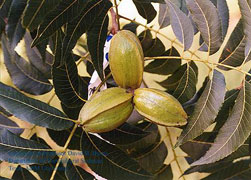


Home
Flowers &
Indoor Plants
Fruits & Nuts
Ornamentals
Vegetables
Special Topics
Resources
Glossary

 |
What about it? The pecan is a native American tree. It is large and stately, with a graceful branching pattern and leaves. Early settlers found it growing over wide areas in many parts of the country, but unfortunately, there are no varieties that perform consistently well in New York state. What is it used for?Pecans are commonly used in baking. Their excellent flavor is enjoyed in out-of-hand eating as well. For the lucky individual with a plentiful supply of pecans, nut butter can be made and enjoyed in the same manner as peanut butter. Where does it grow? How do we grow it? A site with good air drainage is preferable. Pecan trees are grown on a wide range of soils but they all have certain common characteristics: the soil should be deep, loose, and well-drained. Pecans grown on sandy soils (or in hot weather) will need additional water. Pecans will need fertilizer, too. What are its primary problems? Pecan scab is a prevalent disease for pecan growers, especially in areas of high rainfall. Pecans are also afflicted by: crown gall, stick tights, pecan nut casebearer, pecan weevil, aphids, fall webworms, and salt burn. How do we harvest and store it? Some pecans, depending on variety and season, fall on the ground. Home gardeners pick up the nuts by hand, or lay a canvas on the ground to catch the pecans as they fall. Unless you plan on sharing a large portion of the harvest with squirrels, this should be done right away! A healthy, mature tree can bear up to 100 pounds of nuts, so this will be no small task. Store in a cool dry place, or freeze them.
© Copyright, Department of Horticulture, Cornell University. |





